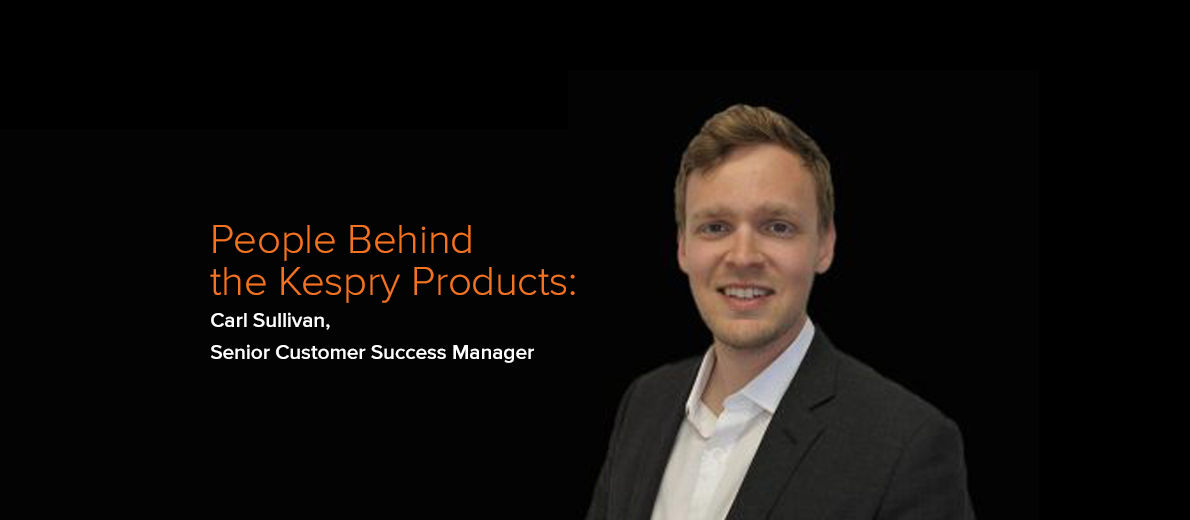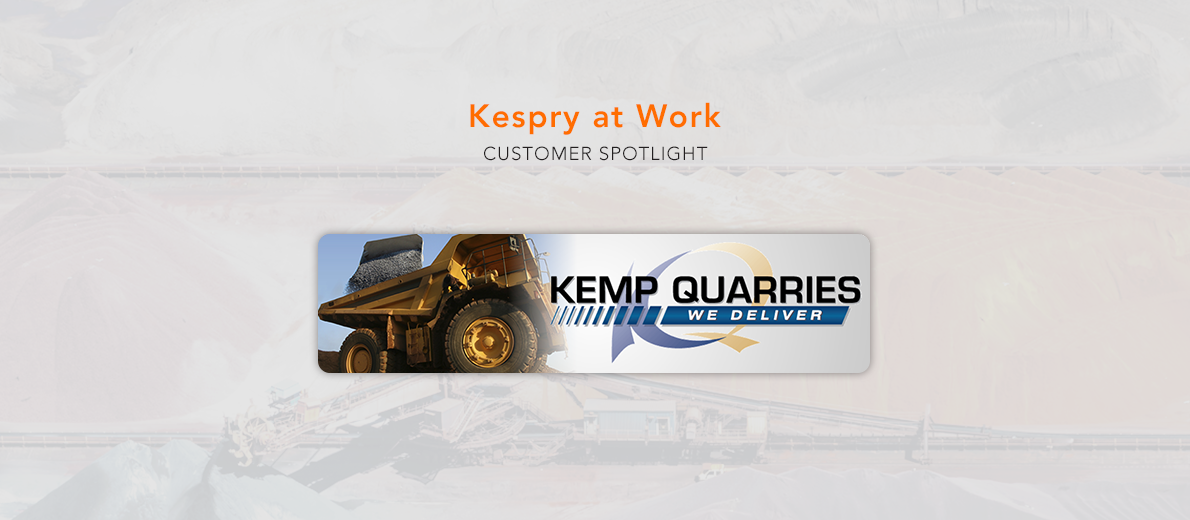Today I’m excited to speak with Carl Sullivan, who is a Senior Customer Success Manager at Kespry.
Carl, thanks so much for joining me today.
Happy to be here.
From your customer success perspective, can you tell me what happens after someone becomes a Kespry customer?
Sure, absolutely. When customers begin with Kespry, they go through an entire customer lifecycle. We take them through the onboarding process and, within that process, we provide services and training for Part 107. Part 107 is your drone licensing, allowing you to operate in compliance with the FAA [Federal Aviation Administration]. We do the drone registration for you. We take you through the entire Kespry Drone and Kespry Cloud training process. As part of the training, we review mission planning and then you actually get to do a flight. We take you through all the tools in Kespry Cloud. We talk with you about your goals and how best to implement the system to get the most value. We are there with you the entire journey. At any point, whether you need any sort of technical consulting or you have questions about use cases, we’ve seen it all, so we’re ready and standing by to help you get the most out of your Kespry system.
If customers have questions – how do they reach out?
Customers have a dedicated account team. In addition to Customer Success Managers, customers also have an Account Manager. Dedicated account managers maintain the relationship with the customer and ensure that they’re reaching their goals.
We also have a dedicated support team. Our technical support engineers are available via email or phone. There is a central number where you can reach them. There are a lot of resources available to customers. You receive a lot of guidance, where you get to meet all of these people at the beginning of your Kespry journey.
Kespry offers the Drone 2s which uses PPK – how are surveyors using Kespry?
There’s a handful of things and what’s really great about the Drone 2s is that on a site, once you’ve established control, you can come in and collect way more data of your as-builts throughout the lifetime of a project. You don’t have to go out and walk the piles or the field or check your grading, spending hours doing that every time that you’re out in the field.
Now with the way the technology is moving you can go out there and fly it in 20 minutes and get way more data than you would have previously.
How easy is it for someone that’s very new to drone technology but has a lot of experience in aggregates, insurance, mining or construction to learn how to use the Kespry system?
It’s extremely straightforward. The Kespry system is designed to be as simple as possible. There are no joysticks. All you’re telling the drone is this is the data that I need. You don’t have to plan the flight path. The Kespry Drone takes off and lands on its own.
Using the Kespry Cloud and sharing data with other people is super easy. You don’t have to download giant files, load them into Dropbox or some other program, in order to e-mail them to a colleague or customer. Files can be viewed and downloaded directly from the Kespry Cloud.
The data is extremely accessible, and the tools in the Cloud are designed to make what used to take hours, simple and easy to do in just a couple of minutes.
How easy is the data to export? Which file types are available?
We support a lot of different file types. The good news is that most CAD programs have a handful of standards that they’re compatible with. All of our data exports work neatly in whatever software environment you like to use. If you’re in Trimble Business Center, AutoCAD Civil 3D, AGTEK, Carlson – you’ll have data that will work with those programs. Some customers like to work with the point clouds because they want as much data as possible. You certainly have that option. We also have a lot of control to customize. Even when working on an old machine.
Let’s go back a bit – where did you grow up?
I’m originally from Chicago. I grew up in the city and the suburbs, so I spent time in and around there.
Growing up in Chicago, what were some of your hobbies?
Oh man, all sorts of things. I was on soccer teams and swim teams all up through high school. I’ve always been sort of a book nerd.
You graduated with a geography degree and a concentration in geotechnology – what inspired you to pursue that?
Sure, it’s kind of a funny story. Initially, I was an international studies major. Nobody goes to college aspiring to major in geography, we all sort of find our way into it. I needed a third lab class and I’d already taken physics and biology and wasn’t really interested in chemistry. I discovered this GIS course which fulfilled the requirement. Once I was in it, I really loved it and found that it was incredibly powerful.
Getting into geography, it’s a very diverse field, very interdisciplinary. It allowed me to do a lot of the same things that I’d wanted to do. Before geography, I was sort of interested in economics and international policy. Geography encompasses all of that, as well as having this really powerful tool from which we can, sort of, look and see the world.
For several years you were a GIS consultant. Can you talk a little bit about the types of projects you worked on?
When I first moved to California, I was working mostly in agriculture. In the Central Valley, there’s a lot of high-value crops such as almonds and grapes.
Initially, I was trying to organize the geographic data that all of the farmers collect – how much yield comes from where, what are their soil types, how much they water and fertilize, the topology of the land, and then gain insights from there.
A lot of what the farmers were interested in was having documents that outline all of their assets. A big value add for them was maps that they could take to banks. Allowing them to take out more loans against their property, so that they could expand their business.
I also did a lot of work with public utilities. PG&E’s updating of all their substations in the Bay Area. Multiple millions of dollar projects.
Having worked with surveyors and currently working in the commercial drone industry, what advice do you have for surveyors who are considering using drone technology?
I’ve done a lot of work with surveyors and have done a lot of different types of survey jobs. The survey industry is kind of interesting, too, because they saw the value really early but the technology wasn’t quite good enough for a long time. Within the last couple of years, we started to bridge that gap and you’re starting to see it as a tool that they’re using more and more. My advice for surveyors? There are a lot of different ways to add value with drone technology. Anything from just having an orthophoto that you can put underneath your drawings is super valuable, and I’ve seen clients really jump at that. Now you’re able to get more detail; you have an extra layer of information that you can use with your walking topos. Having that visual is really powerful and makes sense of any design drawings.
For surveyors that are currently doing a lot of research and they have a lot of questions – what types of questions should they be asking as they’re looking for a drone solution?
You want to be thinking about what kind of surveys you’re doing. The drone really helps with walking topos. You can have a photo with anything, so that’s valuable. You also want to be looking at what your tolerances are. This is something that surveyors are thinking about constantly. How do I tie in those vertical tolerances really tight? How do I get the drone data to work with my software? This was something that was really hard to do five or ten years ago. We’re really starting to see these capabilities within the last year or two.
You have been at Kespry for a while now – what do you love most about being part of the team?
The team that we’ve built is really solid. When I have a question about the drone itself, I can talk to our QA engineers or our hardware team or our electrical engineering team, to learn more about it. I get to see what software is doing on a day-to-day basis and can talk to them about what they’re working on. Management is very visible and available. In addition to that, I’ve gotten to work with people who I admire a lot and get to learn a lot from.
When you’re not busy working at Kespry – what do you like to do for fun?
Well, I really like working for Kespry, so you will probably see me here 10 to 12 hours a day. I’m still a huge book nerd, so I do quite a bit of reading. I try to do a little bit of writing too. Here in California, it’s beautiful, so I like to do a lot of hiking. There’s a lot of stuff to see. Road trips are fun. I also have family nearby. My grandparents are down in Gilroy and I visit them very regularly.
When it comes to books that you enjoy reading, which categories do you enjoy?
I’m a huge nerd, so a lot of science fiction. I’ll also occasionally get into, sort of, more academic things. Before I fell into geography, I’d wanted to get into international policy, so I still read about that from time to time. I’m very interested in the ideas that shape our modern world, what other people are thinking and what we’re doing around the world.
For others in the GIS space, who are considering joining a drone company, what advice do you have for them?
Brush up on your fundamentals. I had a huge advantage in that I was working with survey firms really early and working with people who really cared about data quality. Being very familiar with coordinate systems and how to build one or recreate one is going to be really important to customers in civil engineering, surveying, and construction. Those are going to be really important concepts that you’ll need to understand. The other thing is to familiarize yourself with the tools available. A lot of what exists in the Kespry Cloud are things that GIS folks should be familiar with – how to do volumetrics, compare surfaces and working with raster data.
Your birthday is on Sunday – is there anything that you’re wishing for?
Well, I’m taking a vacation soon, so I’m getting my wish. Very excited for that. Going to check out Napa and then going up to Seattle for a couple of days. I feel really lucky; I sort of have most of the things that I want in life.
Carl, it has been so awesome to chat with you. Thank you so much for making the time today and happy birthday.
Thank you very much.



